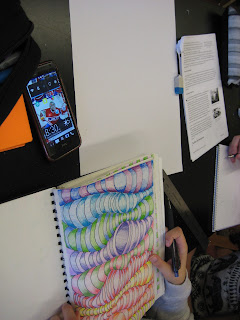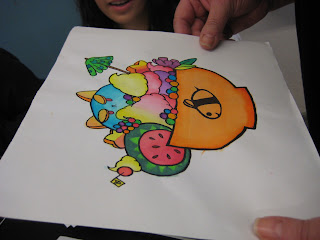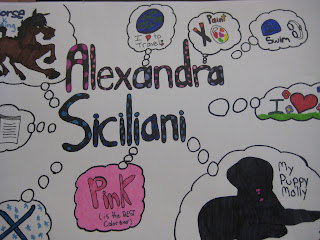Today I visited some classes of an Art teacher, Lily Skuja. She teaches IB and non-IB students; all the students in IB need to take each of the following subjects at least once: Art, Drama and Music.
Example of lettering
She suggests different things to her students and they choose the one they want to do (this is a big difference with our education system: here they seem to want to make the students feel comfortable and happy in the lessons at the same time as they boost their potential).
This year she is doing mandalas and lettering (the art of drawing letters) with some of these groups. As for assessing the students and their work, they always assess themselves first and that helps her to give them a mark since she says judging art is very subjective, but also because she has seen the students work in class - in very rare occasions do students take the things home to finish them off, only when the student is really slow. 20% of the mark of these students is based on participation and effort during the class and the marks they get are the result of an agreement between the teacher and each student: when the student finishes each assignment, he/she fills up the rubric and shows both rubric and assignment to the teacher, who explains why she agrees or disagrees and they decide the final mark. If one student wants to get a higher mark, he/she can redo the assignment before the end of the term. By the way, the end of the first term at the schools in the Lester B. Pearson School Board is 6th November; the second term finishes in February and the third in the first week in June (then there is testing for a couple of weeks)
Period 1: Art 4
Today these students started a new assignment: they will make an art deco poster. First of all, she handed out some information about what art deco is and examples of the kind of work she expects from them. They had just been studying art nouveau so she referred to that to tell the big difference between both types of art: art nouveau is flowery and art deco is lineal and graphic. That introduction took less than 5 minutes and then the students started working on their task for the day: 2 sketches that included lettering and an image.
Lily showed them some examples of posters on the internet but also one made by a former student of hers; they could use their phones or her computer to look for ideas but they couldn't just copy the poster, they had to make their own. She also mentioned her favourite art deco artist, Tamara de Lempicka, and showed some photos to some of her students to see if they would like to get an idea from her work.
Lily showed them some examples of posters on the internet but also one made by a former student of hers; they could use their phones or her computer to look for ideas but they couldn't just copy the poster, they had to make their own. She also mentioned her favourite art deco artist, Tamara de Lempicka, and showed some photos to some of her students to see if they would like to get an idea from her work.
 There are IB students and non IB students in this class but, once the poster is done, IB students have to write a reflection on their work and, apart from mentioning the fact that they are IB students, they have to include certain vocabulary since the expression is really important for their marks.
There are IB students and non IB students in this class but, once the poster is done, IB students have to write a reflection on their work and, apart from mentioning the fact that they are IB students, they have to include certain vocabulary since the expression is really important for their marks.Some of the students finished their sketches in this period and they were told they could do the lettering on the computer and then trace it.
During the class, the students were engaged in conversations, showing their work to each other, but all of them worked and did (most of) what they were supposed to do. Lily had to correct some things students were not doing correctly, for example, eyeballing instead of using a ruler; she taught the whole class and then reminded some students individually. As the students finished their sketches, they got their poster paper and could start working on their actual poster.
These students have to present five drawings by the end of the term (Nov. 6th), apart from the assignments they work on in class. Some students showed Lily some of the other work they have been working on, in some cases to ask for advice, in others to check they were doing the right thing.
These are some of the drawings they do at home
Period 2: Art 2IM
Many of the students in this group have learning disabilities - because of their physical or mental problems; Lily explained to me that when there are coded students in a group, the ratio is 25 students/group, not the usual 34 students/group. Besides, teachers are paid more when they have this kind of students in their classes.
These students were meant to finish their assignment in this class (the had started in the previous lesson): divide a page into rectangles using a ruler, minimum 10 rectangles (the smaller the rectangles, the easier to shade); shade from dark to light in each rectangle, leaving some white at the end; use a 2B or 2HB pencil and do the entire page.
When some students complained that it was difficult, Lily explained to them that it helped them to control their pencils well and showed them a photo of what a page should look like.
Rubric for the shading assignment (a blank one and one with both the student´s and the teacher´s assessments)
First, the students were told to finish their black and white assignments, next they filled up their grading sheet, went up to the teacher's table and showed it to the teacher together with the assignment; after that, they went to the next assignment: shadowing in colours.
Deciding how to grade himself
She reminded students of some important things several times during the class: the need for proper equipment (2B or 2HB pencils), how to press hard at the beginning of the shadowing and release pressure afterwards, how not to smudge the work using a piece of blank paper.
Not all these students were consistent workers, quite a few of them were easily distracted, so she insisted that this was not a homework assignment and, if they socialized during the period while they had not yet done the assignment, there would be a consequence (I guess she meant they would not get 20% for participation and effort in their marks).
As I mentioned before, some students were talkative, distracted and did not get to finish their work, so those students will finish their paper at home because the next class will be the only one to show the coloured piece of work.
Period 5: Grade 8 Art 2IB
These students had to do the same task as the ones mentioned above but they were much focused on their work; they were very talkative, though, probably because of one of these three things: it was the period after lunch ( teachers agree that all students find it harder to work then), they had a Science test the next period, or it is going to snow soon ( teachers find the students go hyper when it is going to snow...)
While these students were working, Lily showed me some of the portfolios they had designed to keep their work during the year. They had to include their name and show their hobbies and then they presented it to the class as an introduction of themselves. Afterwards, they did their self-assessment and wrote the reflection (they are IB students)
While these students were working, Lily showed me some of the portfolios they had designed to keep their work during the year. They had to include their name and show their hobbies and then they presented it to the class as an introduction of themselves. Afterwards, they did their self-assessment and wrote the reflection (they are IB students)
This is the rubric and the reflection for the portfolio above
And the following pictures show some of the drawings and designs they did for an assignment meant to reflect feelings and emotions. I was really impressed by some of the ideas expressed in them (both in the drawings and in the reflections).
Period 6: Textiles and Design. Grade 11
This subject is an elective and most of the students agree on the reason why they have chosen it: they relax during this class but do things - many of them also mentioned they liked the teacher.
Today was the last day to finish their embroidery so they had to fill up their assessments,too.
This is what the students looked like during the lesson:
The students who finished this task could go on to the next one: yarn painting, which consists of drawing a design and gluing yarn on the pattern. By the end of the class, there were students doing different things: the embrodery, the drawings for the yarn painting, and some had already started gluing the yarn.
And last, but not least, this is the project that all Art students will do to celebrate the Day of the Dead, in November. They will do an exhibition of the skulls on that day:
At lunch time, while eating their salads, fruit, microwave-heated/cooked food and sandwiches in the teachers' room, the teachers were talking about the sick days they get per year. The conversation started because many people have big colds these days - no wonder with the fluctuation of temperatures in the day!: they get 6 sick days/year, which you may use or bank. Apparently many people bank them for an early retirement. However, the first time they are hired, they get 6 extra sick days, because they assume you will get sick more often until your immune system gets used to the bacteria at school. There extra days are not bankable, though.
The weather today: 7ºC / 14ºC

































No hay comentarios:
Publicar un comentario